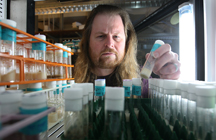Disruption of gene used to transport proteins leads to ALS
December 10, 2012
 |
|
James
Clemens found that a gene - that when mutated leads to a genetic version of
amyotrophic lateral sclerosis - is critical for cell signaling in neurons.
(Purdue Agricultural Communication photo/Tom Campbell)
|
WEST LAFAYETTE, Ind. - A Purdue University biochemist has determined the function of a gene that when mutated leads to a genetic variation of amyotrophic lateral sclerosis, or Lou Gehrig's disease.
James Clemens, an assistant professor of biochemistry, found that a gene called VAPB is responsible for transporting certain proteins to their proper places along neurons. When the gene is mutated or deleted, these proteins are unable to make it to locations in neurons where their function is critically required.
ALS causes neurons to die, slowly eliminating voluntary muscle control and eventually causing death in about five out of 100,000 people worldwide, according to the National Institutes of Health. About 90 percent of the cases are considered sporadic, with no known risk factor. The other 10 percent is due to an inherited genetic defect.
Clemens studied the VAPB gene, which, when mutated, causes a portion of the disease's genetic versions. Using Drosophila, or the fruit fly, as a model, his laboratory determined that VAPB is critical to delivering a cell surface receptor called Dscam - Down syndrome cell adhesion molecule - to the neuron's axons.
"VAPB is important for the trafficking of Dscam and potentially other cell surface receptors down axons," said Clemens, whose findings were published in The Journal of Neuroscience. "This may be the reason why people with mutations of VAPB develop ALS."
Dscam is important for proper neural function. When communication between neurons is disrupted, they undergo programmed cell death. If a neuron dies, it disrupts the signaling chain from the brain to muscles, which results in neurodegenerative diseases, Clemens said.
"Neurons are all connected. The axon of one neuron sends signals to the dendrites of the next neuron in the circuit." Clemens said. "If Dscam and other receptors are not delivered to their proper locations in axons, then the connections between axons and dendrites are destabilized, resulting in neuron degeneration."
In experiments using the Drosophila version of VAPB, the loss of the gene eliminated the amount of Dscam found around the axons of neural cells.
"These findings expand our understanding of the normal cellular functions of VAPB and uncover new molecular mechanisms that potentially underlie the development of ALS," Clemens said. "We hope that our discovery in fruit flies will ultimately lead to the development of new clinical strategies to detect, treat or prevent ALS."
Clemens said it would be important to understand the functions of proteins that VAPB directs to a neuron's axons. His work was funded by the Klingenstein Foundation, the ALS Association and the Canadian Institutes of Health Research.
Writer: Brian Wallheimer, 765-496-2050, bwallhei@purdue.edu
Source: James Clemens, 765-494-1087, jclemens@purdue.edu
ABSTRACT
Drosophila VAP-33 is Required for Axonal Localization of Dscam Isoforms
Zhen Yang, Sung Un Huh, J. Michelle Drennan, Hitesh Kathuria, Juan S. Martinez, Hiroshi Tsuda, Mark C. Hall, and James C. Clemens
Mutations in VAPB have been identified in a familial form of amyotrophic lateral sclerosis (ALS), and reduced VAPB levels have been found in patients with sporadic ALS. Vap protein family members from different species and cell types have been implicated in a number of cellular functions, but how Vap dysfunction in neurons and/or muscles contributes to motor neuron degeneration and death is poorly understood. Using Drosophila as a model organism, we show that Vap physically interacts with and affects the axonal functions of the Down syndrome cell adhesion molecule (Dscam). Dscam is a cell-surface receptor involved in axon and dendritic patterning and neuron self-recognition and avoidance. Alternative splicing of the Dscam transcript leads to the production of Dscam isoforms that contain one of two possible transmembrane (TM) domain and flanking sequences that either restrict the isoform to dendrites and cell bodies (TM1) or target the isoform to axon processes (TM2). We find that Vap specifically interacts with Dscam isoforms that contain the TM2 cytoplasmic juxtamembrane flanking sequences. Using loss-of-function genetics, we further show that Vap is required for localization of Dscam isoforms containing TM2 to axons and that Vap loss suppresses Dscam gain-of-function axon phenotypes. We propose that Vap function is required in neurons to selectively traffic proteins to axons, and disruption of this function may contribute to the pathology of ALS.
Ag Communications: (765) 494-2722;
Keith Robinson, robins89@purdue.edu
Agriculture News Page

